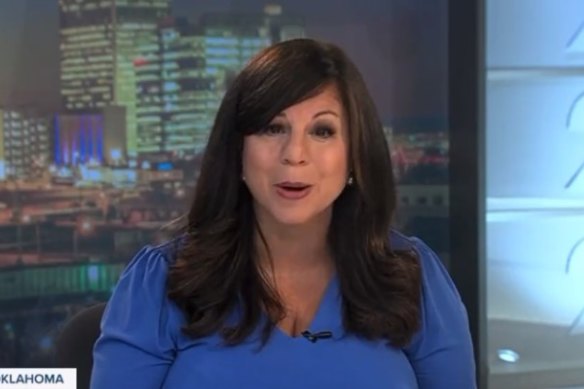Tulsa, Oklahoma anchor Julie Chin was in the middle of a live broadcast on Saturday morning when she said she suddenly lost partial vision in one eye. Then one of her arms started to feel numb. And, when it was her turn to speak, the right words did not come.
To viewers, the KJRH anchor stumbled over her words and appeared confused as she tried to announce a local event connected to a now-delayed NASA rocket launch to the moon.
Oklahoma anchor Julie Chin had the beginning signs of a stroke on-air.Credit:@MikeSington
“I’m sorry,” she said, smiling into the camera. “Something is going on with me this morning, and I apologise to everybody.”
She had the cameras cut away from her and to a meteorologist.
The next day, Chin said in a Facebook post that doctors believe she had experienced the “beginnings of a stroke.”
“The episode seemed to have come out of nowhere,” she explained, adding that test results have “come back great”.
“There are still lots of questions, and lots to follow up on, but the bottom line is I should be just fine,” the veteran television journalist wrote.
Strokes typically take place when blood flow to the brain is cut off, or when a blood vessel bursts or leaks and affects a person’s brain tissue, according to the Mayo Clinic. The symptoms can include paralysis or numbness in the face, loss of vision in one or both eyes, difficulty walking or trouble speaking and understanding language.
Chin wrote on Sunday that what happened to her was “not a full stroke.” Before the show she was feeling great, she wrote, but several minutes into the newscast, “things started to happen.” She described the change in vision and numbness in one of her hands and arms.
“Then, I knew I was in big trouble when my mouth would not speak the words that were right in front of me on the teleprompter,” she wrote.
Her co-workers at the NBC affiliate immediately called emergency services, she said.
“If you were watching Saturday morning,” she added, “you know how desperately I tried to steer the show forward, but the words just wouldn’t come.”
After the ordeal, Chin said she learned that it may not be obvious when someone is experiencing a stroke, but fast action could save a life. She shared an acronym for recognising symptoms and remembering to act. “B.E.F.A.S.T.” stands for a loss of balance, changes in eyesight, facial drooping, arm weakness and speech difficulty, with the final letter meaning time to call 911, Chin wrote.
Similar acronyms have been shared by the Mayo Clinic and the American Stroke Association.
Chin began her journalism career working for various stations in New York and North Carolina before moving to KJRH in Tulsa, where she started covering the weather. She’s now a reporter and anchor for the station’s weekend news show.
Chin is one of several broadcasters to experience a health emergency on the air. During her live talk show in 2017, Wendy Williams suddenly became wide-eyed and collapsed onstage, returning minutes later to explain that a Statue of Liberty costume she was wearing for a Halloween-themed episode had been too hot. Williams later said she had fainted.
That same year, Philadelphia news anchor Gray Hall was rushed to the hospital after he started slurring his words on-air. Tests showed that Hall had a cyst on his brain, and the anchor underwent emergency surgery. And in 2011, Los Angeles journalist Serene Branson became incoherent during live coverage on the Grammys. Doctors said she had suffered from a complex migraine, and Branson told the Los Angeles Times the episode left her feeling “terrified” and embarrassed.
In response to viewers asking about Chin’s condition, KJRH on Monday shared Chin’s Facebook post. “We’re wishing her the best on her road to recovery and well-deserved rest,” the station wrote.
Chin wrote on Sunday that she will undergo more tests, but will be back on the air in a few days.
“Thank you all for loving me and supporting me so well,” she wrote.
Washington Post
Get a note directly from our foreign correspondents on what’s making headlines around the world. Sign up for the weekly What in the World newsletter here.
Most Viewed in World
From our partners
Source: Read Full Article
